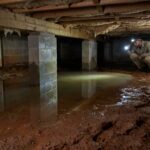Essential Guide to Foundation Repair: Protecting Your Home from Structural Damage
When you think about the foundations of your home, what comes to mind? Surely not the fun times at barbecues or family gatherings. Instead, your foundation is probably more like the unsung hero of your home—the sturdy, reliable support that stands firm against the elements (and maybe the occasional neighborhood raccoon). Unfortunately, just like any good housemate, foundations can develop issues over time, and it’s critical that we address those problems before they escalate into something far worse. Welcome to your essential guide to foundation repair—a topic that may not be the most exhilarating but is definitely crucial to safeguarding your home!
Understanding the Basics of Your Foundation
Before diving into repair methods and prevention strategies, let’s take a moment to understand what a foundation does. Think of your home as a delightful cake, and the foundation is the plate that keeps everything steady. It supports the weight of the entire structure and protects it from moisture, pests, and those pesky seasonal shifts in soil. In residential buildings, there are typically two main types of foundations: slab and basement.
1. **Slab Foundation**: This is a solid concrete slab that lies directly on the ground. Slab foundations are quite common in warmer climates where frost isn’t much of an issue. They are relatively simple, cost-effective, and less prone to flooding (unless you live in a swamp, then all bets are off).
2. **Basement Foundation**: These foundations extend below ground level, creating a space for a basement. While great for storage or as a cozy hangout spot during snowstorms, they require more maintenance and can be more susceptible to water damage.
Recognizing Signs of Foundation Issues
Now that we’ve established what your foundation is, it’s time to chat about how to recognize when your foundation might be throwing a tantrum. Here are some signs that should send you sprinting to your local foundation repair expert faster than you can yell, “What’s that crack?!”
1. **Cracks in Walls and Floors**: Small hairline cracks may be perfectly normal, but if you notice larger cracks that are widening, it’s time to investigate. Keep an eye out for vertical cracks that appear suddenly—like a surprise party for your walls.
2. **Doors and Windows Sticking**: If you find yourself wrestling with doors and windows that refuse to budge, your foundation could be shifting. Just like trying to fit a square peg in a round hole, things can get messy when your foundation isn’t cooperating.
3. **Uneven Floors**: If you’re feeling like you’re walking on a rollercoaster while moving from room to room, your floors may be sloping due to foundation issues. No, you don’t need a map to navigate; it’s time to call in the professionals.
4. **Gaps Around Windows and Doors**: If there are gaps between your windows, doors, or the house frame, that’s a big red flag. It’s like your house is developing a case of separation anxiety!
5. **Water Accumulation**: Puddles forming near your foundation after rain? That’s not just nature having a bad day; it could be a sign of drainage problems leading to water pooling around your foundation and causing erosion.
The Causes of Foundation Problems
You might be asking, “Why is my foundation acting like a teenager with mood swings?” Well, various factors can lead to foundation damage:
1. **Soil Movement**: Clay soils can expand and contract significantly depending on moisture levels. If the ground under your foundation shifts, it can lead to cracking and settling.
2. **Poor Drainage**: If your yard doesn’t drain properly, water can accumulate around your foundation, leading to erosion and weakening the structural integrity.
3. **Tree Roots**: If you have large trees nearby, their roots can invade and disrupt your foundation, much like a nosy neighbor invading your personal space.
4. **Construction Quality**: Sometimes, foundations are compromised during the initial construction phase due to poor materials or improper installation. It’s like finding out your cake was made with expired ingredients!
5. **Seismic Activity**: In areas prone to earthquakes, soil movement can significantly impact foundation stability. No pressure, right?
Prevention is Key
While it’s vital to know how to deal with foundation issues if they arise, being proactive is the best strategy. Here are some preventive measures to keep your foundation stable and happy:
1. **Maintain Proper Drainage**: Ensure that your gutters are clean and functional, and direct downspouts away from your foundation. If your yard resembles a swamp, consider installing drains to channel water away.
2. **Manage Landscaping Wisely**: Avoid planting trees or large shrubs too close to your foundation. Their thirsty roots will suck up moisture and cause the soil beneath your foundation to dry out.
3. **Watering Routine**: During dry spells, water your foundation gently to maintain moisture levels in the soil without oversaturation. Think of it as giving your foundation a nice spa treatment.
4. **Monitor Your Home’s Condition**: Regularly check for any signs of stress in your walls, floors, and ceilings. Catching issues early can save you from bigger headaches down the line.
It’s Time to Call in the Pros
If you’ve spotted any of those troubling indicators, it’s time to reach out to a foundation repair specialist. While DIY fixes may seem like a tempting option, foundation repair is not a weekend project (unless you enjoy the thrill of potential collapse). Pros have the expertise, the tools, and the experience to diagnose and fix foundation issues safely and effectively.
When selecting a contractor, consider the following:
1. **Check Credentials**: Ensure they are licensed and insured. You wouldn’t hire a chef who can’t boil water, right?
2. **Look for Experience**: Read reviews, ask for references, and seek out contractors with experience specific to your foundation type.
3. **Get Multiple Quotes**: Don’t settle for the first estimate. Getting several quotes will help you understand the average cost and ensure you aren’t getting taken for a ride.
4. **Ask Questions**: Don’t hesitate to inquire about repair methods and materials. A reliable contractor will be happy to explain their process—after all, it’s your house!
Understanding Repair Methods
Once you’ve selected a contractor, they’ll evaluate your situation and recommend the appropriate repair methods. Here are some common solutions:
1. **Piering**: Also known as underpinning, this method involves drilling deep into stable soil to stabilize and lift the foundation. Think of it as giving your home a pair of stylish high heels.
2. **Slabjacking**: For slab foundations, this method involves injecting a polyurethane foam or a cement mixture underneath the slab to lift it back to its original level. It’s like a little boost for your home’s foundation!
3. **Wall Anchors**: If your walls are bowing or leaning, wall anchors can be installed to pull them back into position and secure them. It’s a little reinforcement that says, “Stand tall!”
4. **French Drains**: To address drainage issues, French drains can be installed to move water away from your foundation. Yes, they were named after someone named ‘French,’ and no, they do not involve any croissants.
In Conclusion
The foundation of your home is crucial for its stability and longevity. By understanding the signs of foundation issues, the causes behind them, and how to prevent them, you can save yourself the headache (and heartache) of costly repairs down the line. A sturdy foundation means a safe home, and who doesn’t want to keep their castle intact?
Just remember, whether you’re keeping an eye on those swirling cracks or ensuring your gutters are flowing freely, a little vigilance goes a long way. Protect your sanctuary wisely—it’s the only one you’ve got! So, put on your detective hat and keep your foundation healthy. And don’t forget, when in doubt, call the experts. After all, the only cracks you want in your life should be the ones in your favorite mug after many years of loving use!


